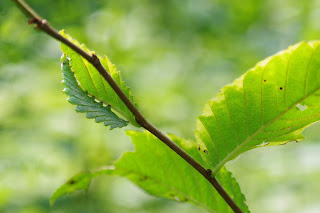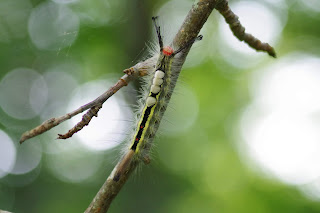Backyard Bug of the Day:
I thought this was going to be easy to identify, but looking through my caterpillar book, apparently not. It doesn't look like the pictures. I am fairly certain this is a furcula caterpillar, but I can't tell which species. It should have been Backyard Bug of the Day yesterday, but I didn't think I got a good enough picture of it. I didn't really get what I consider good enough pictures today, either, but today's choices for BBotD were not stellar. So... This is a pretty interesting caterpillar. It makes a mat of silk on whatever leaf it has chosen to hang out on (why, I don't know), and when it feels threatened it does a couple of things. It sits up like this picture, or...
... It waves its forked tail around.
Other Bugs:
Can you spot the cicada?
I'm finding a lot of stinkbug nymphs lately:
Nope, nobody here but us leaves...
Grasshopper nymph
Assassin bug with bee prey
So, here's the thing I learned today: the identity of some caterpillars I have seen in the backyard lately. And I learned it in a more interesting and reliable way than looking it up; I observed what happened in my backyard. I found this today:
Ailanthus webworm moth. One of the few moths I can identify on sight, because it is very distinctive looking. Usually I see them either on my front porch, attracted to the lights, or on goldenrod flowers. But I spotted this one on a web. Not a spider web, but a caterpillar web:
This is one of a few caterpillar webs that I found in my backyard about 2 weeks ago; they all had caterpillars in them then, but soon they had chrysalides instead. I didn't know what kind of caterpillars they were, some kind of tent caterpillars I supposed. But finding an ailanthus WEBWORM moth in one of these silk structures made me realize that those caterpillars must have been ailanthus webworms. Now, I suppose it is possible that this moth just happened to have landed there. And none of the chrysalides in this web look like they have just been vacated, they both still look full (there may be others I can't see, hidden among leaves). But I remember now that last year I found a chrysalis that looked like these and kept it in my bug viewer until the moth came out, and it was an ailanthus webworm moth. So...
... obviously the caterpillars that became these chrysalides were ailanthus webworms. And now I know what they were just because of paying attention to what's going on in my backyard.
Soon there will be more moths...
And speaking of moths, here's another one. Some species of geometer.
White marked tussock moth caterpillar
Bee
Katydid
Soon these caterpillars will be heading up to the top of the enclosure to become chrysalides...
There were two that underwent the process today.
I happened to have the lucky timing to see this one, which makes two days in a row I got to see this extraordinary procedure.
The hatchling is growing...
And I had a surprise today. I noticed that the leaves of one of the milkweed cuttings I brought in last week with one of the above caterpillars on it had been eaten in a way that was more like a young caterpillar than one in the later instars like the caterpillar that came in on the plant. And then I spotted this little one, about half an inch long, which had obviously been on the plant when I brought it in, but was too small for me to notice it. It is lucky it didn't get eaten by the bigger caterpillar if they were sharing a plant when this first hatched; larger caterpillars will eat eggs and newly hatched caterpillars if they happen to be on the leaves they are eating.
Katydid, female, on autumn joy sedum
I found something kind of... unusual in the backyard today:
On a rock in the rock garden, and one that I walk on all the time, so I know it wasn't there yesterday, a partly eaten, dried out frog corpse. I did not examine it closely. I just took its picture and left it there, mystery that it is. Obviously some animal left it there, but why not eat the whole thing?
It's fun to watch a tiny jumping spider walk along the spiny branches of a raspberry bush. You can't see it in the picture, but they leave a trail of silk as they go, and sometimes I find raspberry branches that have quite a lot of silk running along them.
Bowl-and-doily spider

































No comments:
Post a Comment